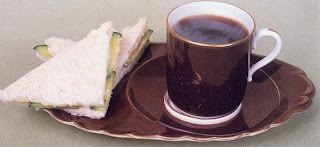I recall that the Lawn Tennis Museum at Wimbledon has some Spode pieces in its collection made during the Copeland ownership of the company. It includes a jelly/blancmange mould with crossed tennis rackets, tennis balls and nets as the design. I would have liked to have to seen (and perhaps tasted) the jelly/blancmange made from it! Other objects were made too, sometimes in conjunction with a metalware manufacturer, for example a ceramic dish fitting into a suitably tennis-themed, silver-plated stand.
 |
| Tennis Set c1869 |
Interestingly these were aimed at the highest end of the market with renowned Spode artists painting the intricate and beautiful designs (the Spode pattern books record the names) and with raised and chased gold decoration on the finest bone china.
They seem to be uncommon...the one illustrated above is a plainer version. But it is still decorated with a complicated and expensive method known as 'groundlaying' in a deep crimson and is also gilded. This shape design was registered with the British Patent Office in July 1869.
 |
| Tennis set from The Met Museum c1871 |
In about 1870 the 'tennis set' shape was also used for a beautifully handpainted and gilded Christmas pattern of holly and mistletoe presumably unconnected with tennis but perfect for coffee and a mince pie!
Later in the 20th century this elongated shape was revived by Spode as the slightly more mundane 'TV plate' to accompany that new-fangled invention, and later still, in the early 21st century, as a 'tea and toast' set.
 |
| Spode Wimbledon centenary plate (detail), 1977 |
Another Stoke-on-Trent pottery manufacturing family, the Shelleys were responsible for introducing tennis to North Staffordshire. Thank you to my sister, Val Bott, for the research. She, with our parents and brother, owned and lived in the Shelley's house, The Southlands, for a time. I didn't exist then so was born too late for this treat! The tennis courts were, I believe, still there in the grounds at that time.
